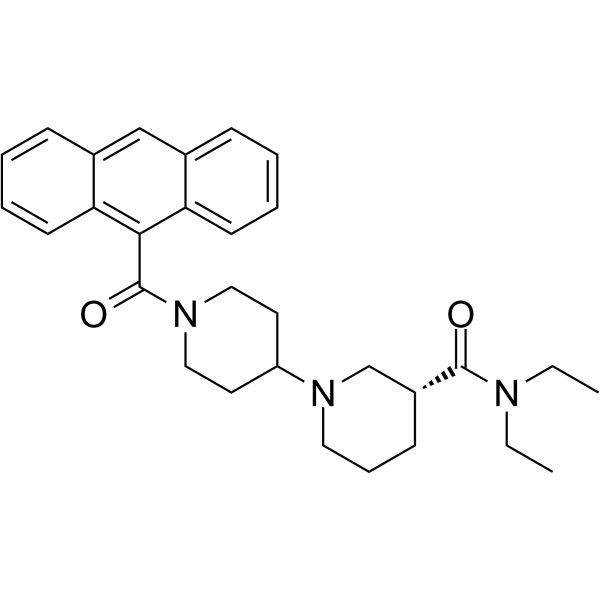| In Vitro |
CP-610431 is the active R-enantiomer of CP-497485. CP-610431 is more potent than the racemate CP-497485 in inhibiting rat ACC1 (IC50=35.7 nM) and ACC2 (IC50=55 nM), whereas the S-enantiomer, CP-610432, does not substantially inhibit either ACC isoform at concentrations of up to 3 μM. CP-610431 is more potent than CP-497485 in inhibiting HepG2 cell fatty acid and triglyceride (TG) synthesis and in inhibiting TG and apoB secretion[1]. CP-610431 inhibits fatty acid synthesis, triglyceride synthesis, TG secretion, and apolipoprotein B secretion in HepG2 cells (ACC1) with EC50s of 1.6, 1.8, 3.0, and 5.7 μM, without affecting either cholesterol synthesis or apolipoprotein CIII secretion[1]. CP-610431 inhibits both liver and skeletal muscle ACC activity from all three species with essentially equal potency (rat, 36 versus 55 nM; mouse, 50 versus 63 nM; cynomolgus macaque, 70 versus 26 nM) [1]. CP-610431 inhibits mouse primary hepatocyte fatty acid and TG synthesis with IC50 values of 0.11 and 1.2 μM and inhibits TG secretion with an IC50 of 10 μM[1]. Cell Viability Assay[1] Cell Line: HepG2 cells Concentration: 0.1, 1, 10 μM Incubation Time: 24 hours Result: Dose-dependently inhibited HepG2 cell fatty acid synthesis with an IC50 of 1.6 μM, TG synthesis with an IC50 of 1.8 μM, TG secretion with an IC50 of 3.0 μM, and apoB secretion with an IC50 of 5.7 μM.
|
| In Vivo |
CP-610431 inhibits fatty acid synthesis in CD1 mice and ob/ob mice within 1 h after dose with ED50s of 22 and 4 mg/kg, respectively[1]. Animal Model: CD1 mice[1] Dosage: 30 and 100 mg/kg for fasting CD1 mice; 10, 30, and 100 mg/kg for non-fasting CD1 mice Administration: Intraperitoneal administration; 1 hour Result: Inhibited hepatic fatty acid synthesis in fasting CD1 mice by 64±12%, and 77±4% at doses of 30 and 100 mg/kg, respectively. Inhibited hepatic fatty acid synthesis in non-fasting CD1 mice by 18%, 51%, and 75% at doses of 10, 30 and 100 mg/kg, respectively.
|
